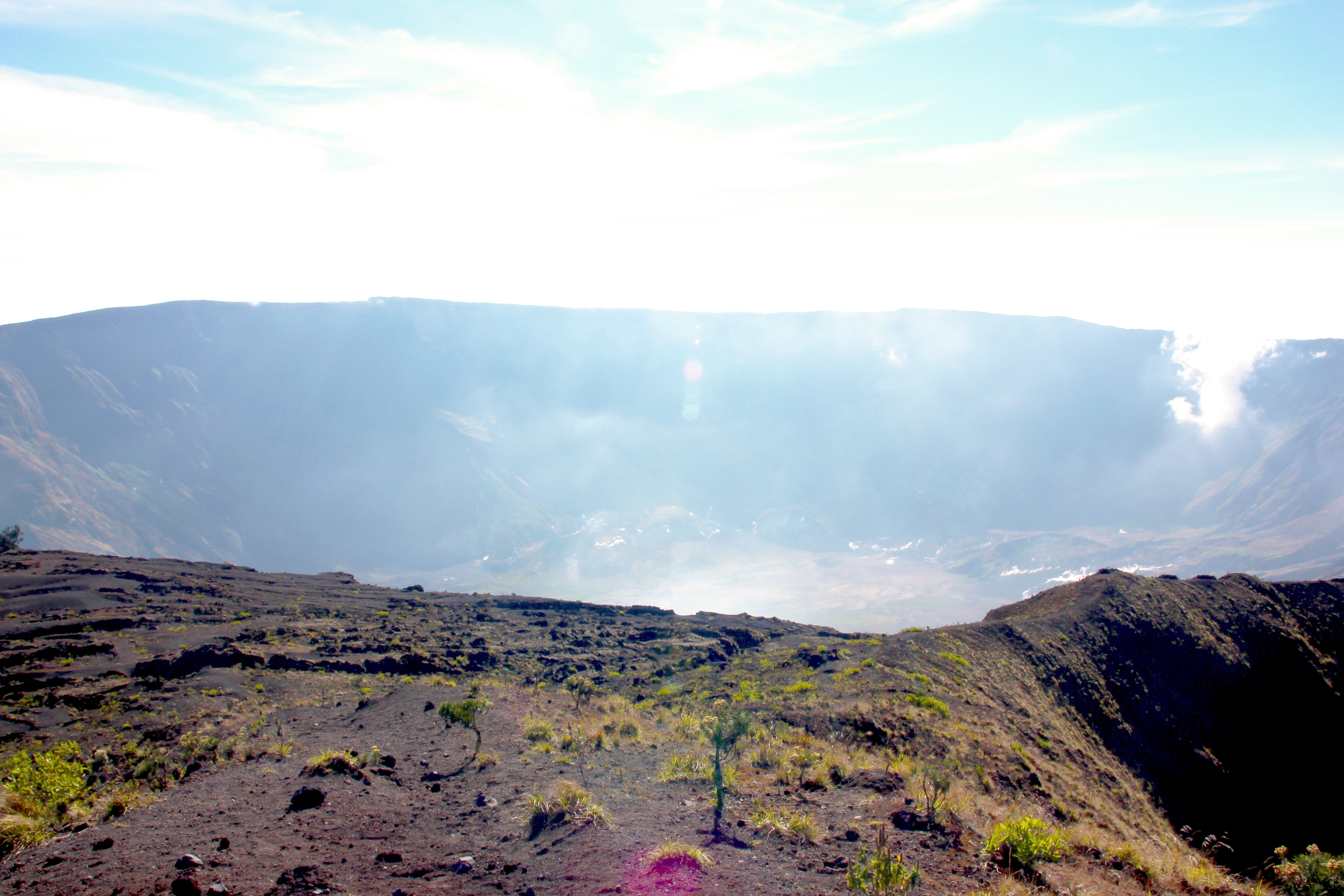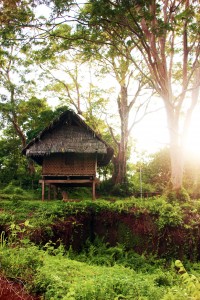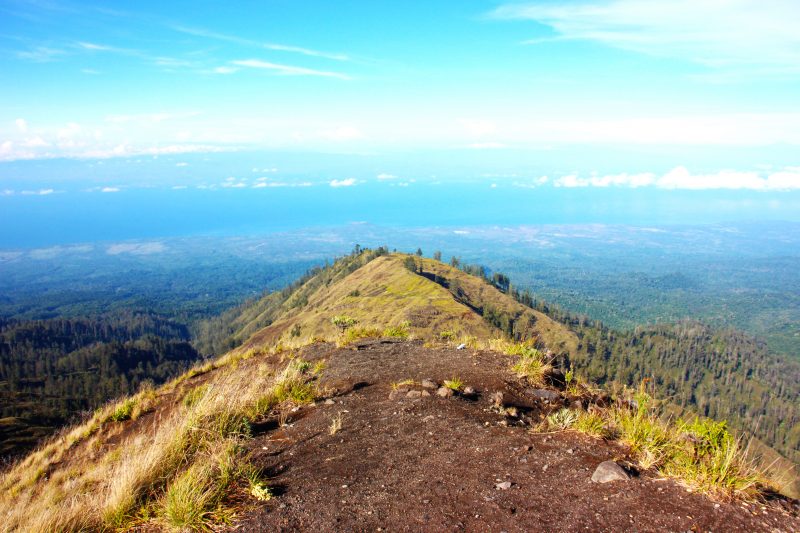In addition to changing the global climate through “The Year Without Summer” and losing nearly half of its original altitude, Mount Tambora’s 1815 super eruption also annihilated the three Central Sumbawa kingdoms of Tambora, Pékat and Sanggar. In an ascent to Mount Tambora, Grace Susetyo attempts to piece together the puzzle of Central Sumbawa’s lost civilization.
If 1815 is relatively recent in historical terms – and happened centuries after Sumbawa had become Islamized, commenced international trade with China and Europe and fought wars against the Dutch East India Company – I find it mind-boggling that there are very few reliable written records on the now-extinct civilization of Tambora.
In Bima language – the mother tongue of Tambora inhabitants today – ta mbora literally means ‘an invitation to disappear.’ Prior to 1815, Central Sumbawa spoke a now-extinct language, which according to Raffles’ list of words is now understood to belong to the westernmost group of Papuan languages – in contrast to Bima and Sumbawa languages that are Austronesian. This suggests that Tambora might have been an exonym labelled out of contempt, rather than a name that a people used to identify with. But if this were true, I have yet to find out what Tambora’s original name might have been.
An Arab script written by Makassar historian Abdul Wahab – discovered in the 1820s by retired Dutch soldier PP Roorda van Eysinga – tells the story of Said Idrus, an Arab sheikh from Bengkulu who went to perform midday prayers in Tambora. In the mosque, he found a dog – an abomination in Islam – which he expelled and commanded the guard to beat up. When the guard told Said Idrus that the dog belonged to the raja, the sheikh replied that the masjid is the house of Allah and called the dog’s owner a kafir (infidel).
Enraged, the raja slaughtered his dog and served it for dinner to the sheikh, disguising it as mutton. The raja’s army arrested the sheikh and murdered him on the top of Mount Tambora – then a harsh, icy and deadly volcano standing 4,300 metres high. As the army descended after the execution, the volcano thundered with monstrous pyroclastic flows.
The super eruption happened on April 5, 1815. Van Eysinga described Tambora as going ablaze in nearly two weeks of fire on land and sea, consuming more than 10,000 people. A cyclopean cloud of sulphur dioxide enveloped countries over oceans, preventing solar radiation from entering the atmosphere and lowering global temperature to the point of making the Northeast USA snow up to 15 centimetres high in June of 1816. Two years of raining volcanic ashes rendered Sumbawa’s land barren for three years, and the climate change destroyed agricultural cycles around the world, causing famine and disease. Tambora’s height got reduced to 2,851 metres above sea level. A tsunami drowned seven small coastal countries and floated merchant ships away to the interiors of the islands.

Sumbawa Besar-based cultural activist Syamsu Ardiansyah is a passionate researcher of Tambora’s history and folklore and the super eruption’s impacts on Nusantara spirituality today. “I believe this legend [of the curse of Said Idrus] is an attempt to twist facts out of political interests to compete for legitimacy as Islamic aristocrats,” said Ardiansyah.
He added that Tambora converted to Islam centuries before Bima did, and before the super eruption, it was known as a more thriving civilization compared to Bima. However, Tambora was frequently at war with neighbouring Sumbawa (the Sumbawa Besar-based sultanate spanning the western half of Sumbawa island) and Bima. Hence, the surviving neighbours’ vested interests in inventing narratives of contempt to taint memories of the annihilated civilization.
As a child, Ardiansyah recalls his grandmother telling him bedtime stories of the war between Jaran Pusang and Tambora. Jaran Pusang – a stallion that collapses as his leg gets shot by arrows – is a personification of the tallest mountain belonging to the Sultanate of Sumbawa. Tambora in this tale is represented by an unknown mythical being. In the war, Tambora’s head was struck by Jaran Pusang’s weaponry, which leaves a mark in the form of the seven-kilometre caldera near Mount Tambora’s summit today. Currently, it is the largest active volcanic caldera in the world.
“When a culture tells tales of war and catastrophes, there is usually some rational historical truth that inspired the creation of such tales,” said Ardiansyah. “Even if it’s an oral culture, we can and should objectively identify geographical and personal references packaged in the tales, the historical context in which they are told, and what political interests may have been vested in telling these tales.”
He added that a common example of this political interest is demonstrated in the ubiquity of tales about the union between earthly men and celestial nymphs. These stories are localized across cultures to establish a perceived divinity in foreign conquerors looking to subject local peasants under aristocratic rule.
I responded to Tambora’s ‘invitation’ and ‘disappeared’ for a week there. Upon arrival, I learned that Tambora was somewhat off the telecommunication network’s grid, so I scared my parents by failing to call them.
The off-road motorbike ride across the jungle to Situs Tambora, which is the archaeological site where entire pre-1815 villages were excavated under now-vegetated pyroclastic material, turned out to be more interesting than the visit to the site itself. Artefacts were backfilled into the ground as taking them out to the museum might cause more damage. But that means you can’t see these artefacts at the site either. Only a replica of a house thought to resemble the architecture of the time stood over the site.
A small cupboard of fragile, damaged artefacts are stored in a nearby Dutch colonial house that serves as a Pusat Informasi Situs Tambora, but this is far from a proper museum. Perhaps a better place to see relicts of Tambora’s history is the Balai Arkeologi in Denpasar, which is the current authority over Situs Tambora.
The hike was much easier than that of Rinjani, ascending gradually through thick canopies of fresh-scented rainforests. Nevertheless, it was a trying long walk in the dark, sometimes under heavy rain and picking out blood-sucking leeches. Watching the sunrise over the majestic caldera and fields of edelweiss at the top was an indescribable feeling. As I climbed to the Indonesian flag flying over the summit, looking over Moyo and Satonda islands in the calming blue Gulf of Saleh, I took a moment of silence to make sense of the catastrophe that obliterated an entire civilization two centuries ago.
To arrange a visit to Tambora, Saiful Bahri is contactable at +62 823 4069 3138. Bahri owns an affordable homestay in Pancasila village and is in charge of entries to the Mount Mutis National Park.
Fast Facts
Country: Indonesia
Province: Nusa Tenggara Barat (NTB)
Land area: 71,644 hectares (Taman Nasional Gunung Tambora)
Largest city: Dompu (Dompu Regency), Sumbawa Island
Population: 6,575 (2010 estimate of Tambora district)
How to get there: Daily flights into Sumbawa Besar from Lombok and Bali
Car rental from Sumbawa Besar to Pancasila (6-7 hour drive).
Alternatively, take a ship from Labuhan Badas (Sumbawa Besar) to Calabai, and catch a public bus from Calabai to Pancasila.
What to bring: Camera, hat, sunscreen, insect repellent, hiking shoes, backpack.
Flashlight, extra batteries, power bank – electricity supply is unstable.
A no-frills cellphone (non-smartphone) may be able to catch telecommunication networks sometimes.
If hiking: 3 litres of bottled water per person and groceries for meals, 2 sets of layered winter clothes, raincoat, trash bags. Tents, sleeping bags, cooking equipment and carrier backpack available for rent.
Long-sleeved clothes and salt for repelling leeches.
Cash for transactions – nearest ATMs are located in Kadindi, about 30 minutes drive from Pancasila.




